Since at least early 1911, the Mergenthaler Linotype Company employed a triangle (sometimes with MLCo inscribed in it) as a trademark to identify many of their parts. In particular, they used a triangle (with nothing inscribed inside it) as a part of the code identifying each of their matrices. Here is an example:
The triangle signifies that this is a matrix manufactured by the Mergenthaler Linotype Company ( other makers used different symbols and systems of marking).
The number to the left of the triangle ("24") indicates the body size of the type in the main casting position, in points (24 point). It does not simply indicate the point size of the matrix, as is often said. Some matrices (including this one, as it happens) have different body sizes in the auxiliary casting position.
The number to the right of the triangle uniquely identifies this matrix font within Mergenthaler's 24 point matrices. Thus this matrix, 24 TRIANGLE 122 is "Spartan Black Condensed with 18 Point Spartan Heavy." This number ("122" here) does not identify the typeface. Thus, while 18 TRIANGLE 122 is "Spartan Black Condensed with 14 Point Spartan Heavy," 8 TRIANGLE 122 is "Century Expanded with Century Bold" and 10 TRIANGLE 122 is "Ronaldson with Title No. 1". In order to identify a typeface on a matrix, you must use the entire code (both numbers, before and after the triangle). The number after the triangle is by itself without meaning.
The matrix bears two additional markings.
The "Hy" indicates that this is a hyphen (to distinguish it from other forms of dashes). Indications such as "Hy", "CAP", etc. could be stamped here to to distinguish potentially confusing matrices (e.g., capital O vs. figure 0). Matrices not subject to such confusions were not marked in this position.
The pattern of four dots is a factory code which encodes the date of manufacture, by six-month periods. In order to assure the best possible alignment, customers ordering additional matrices would cite this pattern of dots (or sometimes dashes, 'x', or other markings) and Mergenthaler would attempt to supply matrices from stock from the same six month period. The chances of perfect alignment were better with matrices from the same production run. (My thanks to Dave Seat (Hot Metal Services, http://www.hotmetalservices.com/ ) and Patrick Leary for their assistance in understanding the purpose of this code.)
Spaces, which have no particular body (point) size, are often marked simply with the triangle and their thickness in decimal inches.
With regret, I must observe that much of the following text, including the reference to the work of Jim Gard, was copied verbatim in Frank Romano's History of the Linotype Company (Rochester, NY: RIT Press, 2014), p. 444, without any attribution to its source here. This was done without my knowledge or permission (which I would certainly have given, had I been asked). It is unfortunate that the readers of his book were deprived of the opportunity to go directly to the source information reprinted here.
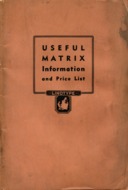
Useful Matrix Information (1st ed., 1934)
610.11, Printing dated 08-34. Price list dated March 1934. The final "dot number" in Mergenthaler document numbers indicates revision level, and is absent for the initial version (no revisions yet). So "610.11" is the initial version, "610.11.1" will be the first revision (thus second edition), and so forth.
The icon links to a presentation of this at The Internet Archive. Here is a local copy of the PDF (438 Megabytes): mlc-useful-matrix-information-610-11-1934-0600rgbjpg.pdf
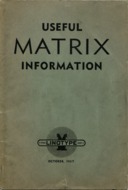
Useful Matrix Information (2nd ed., 1937)
610.11.1-J-P-22X, October 1937.
The icon links to a presentation of this at The Internet Archive. Here is a local copy of the PDF (743 Megabytes): mlc-useful-matrix-information-610-11-1-J-P-22X-1937-10-0600rgbjpg.pdf
This edition is also online in a different scan at Bill Spurling's http://www.Linotype.org/, Lance Williams' site, http://downloads.lwwilliams.com/, and Dave Hughes' MetalType, http://www.MetalType.co.uk/ (all three are the same file).
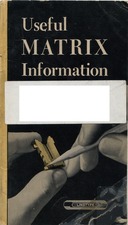
Useful Matrix Information (3rd ed., 1945)
610.11.2-B-X-24X. Dated 1945 on title page.
The icon links to a presentation of this at The Internet Archive. Here is a local copy of the PDF (390 Megabytes): mlc-useful-matrix-information-610-11-2-B-X-24X-1945-0600rgbjpg.pdf
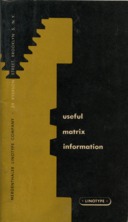
Useful Matrix Information (4th ed., 1959)
610.11.3-K-XX-13X. This booklet is undated, but Jim Gard of the San Jose Printers' Guild has cracked the Mergenthaler publication code and determined that "K-XX" designates "11-59", or November 1959.
The icon links to a presentation of this at The Internet Archive. Here is a local copy of the PDF (513 Megabytes): mlc-useful-matrix-information-610-11-3-K-XX-13X-0600rgbjpg.pdf
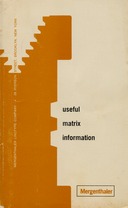
Useful Matrix Information (5th ed., 1966)
610.11.4-5-66-20X.
The icon links to a presentation of this at The Internet Archive. Here is a local copy of the PDF (535 Megabytes): mlc-useful-matrix-information-610-11-4-5-66-20X-0600rgbjpg.pdf
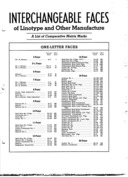
"Interchangeable Faces" (1935)
"Interchangeable Faces of Linotype and Other Manufacture: A List of Comparative Matrix Marks." (Brooklyn, NY: Mergenthaler Linotype Company, n.d. [1935]). A list of matrix series equivalent between Mergenthaler and "other manufacture" (meaning Intertype). The Linotype printing code, cracked by Jim Gard, indicates that this document was printed in July 1935. Printing code: 312.79-F-N-20X. Thanks are due to Jim Gard for scanning this document and allowing its reprinting here.
This section is primarily of historical interest; it is not relevant to the identification of the vast majority of surviving Mergenthaler matrices. For over a century, triangle numbers (as described above) have been used universally.
Initially, the use of the Mergenthaler-trademark triangle for matrix identification was for factory use only. In The Linotype Bulletin, Vol. 7, No. 1 (January, 1911), p. 3, Mergenthaler cautions users specifically against "trying to order sorts or fonts by their [the triangle numbers'] aid." Matrices were officially identified by font slots and face notches, and Mergenthaler sold a small gauge which would translate these into text descriptions of the matrix.
(Digitized by Google from the University of Michigan copy, and available via The Hathi Trust (Hathi ID: mdp.39015086793794))
Within a few years, their position had moderated slightly. In The Linotype Bulletin Vol. 11, No. 1 (August, 1914), pp. 8-9, they advise customers to buy only genuine Mergenthaler matrices identified with triangle-number codes (but stop short of saying that customers should order by means of these codes).
(Digitized by Google from the University of Michigan copy, and available via The Hathi Trust (Hathi ID: mdp.39015086793778))
(For The Linotype Bulletin Notebookon CircuitousRoot, see: ../../ Literature for Composing Linecasters -> Mergenthaler Linotype -> Sales Literature -> Serial Sales Publications -> Linotype Bulletin )
The editions of Useful Matrix Information and "Interchangeable Faces" reprinted here have all entered the public domain either due to publication in the US without copyright notice at a time when such notice was required to secure copyright or failure to renew copyright as then required. Their reprints here remain in the public domain.
The volumes of The Linotype Bulletin excerpted from here have entered the public domain due to the expiration of all possible copyright. The exceprts here remain in the public domain.
The photograph of a matrix here is one taken by me and is technically copyright 2012 by me and licensed under the same Creative Commons Attribution-ShareAlike license as the rest of this page. But if you really need a public domain photograph of an old and rather battered Linotype mat, just go ahead and use it - it isn't that important.
All portions of this document not noted otherwise are Copyright © 2012 by David M. MacMillan and Rollande Krandall.
Circuitous Root is a Registered Trademark of David M. MacMillan and Rollande Krandall.
This work is licensed under the Creative Commons "Attribution - ShareAlike" license, version 4.0 International. See http://creativecommons.org/licenses/by-sa/4.0/ for its terms.
Presented originally by Circuitous Root®